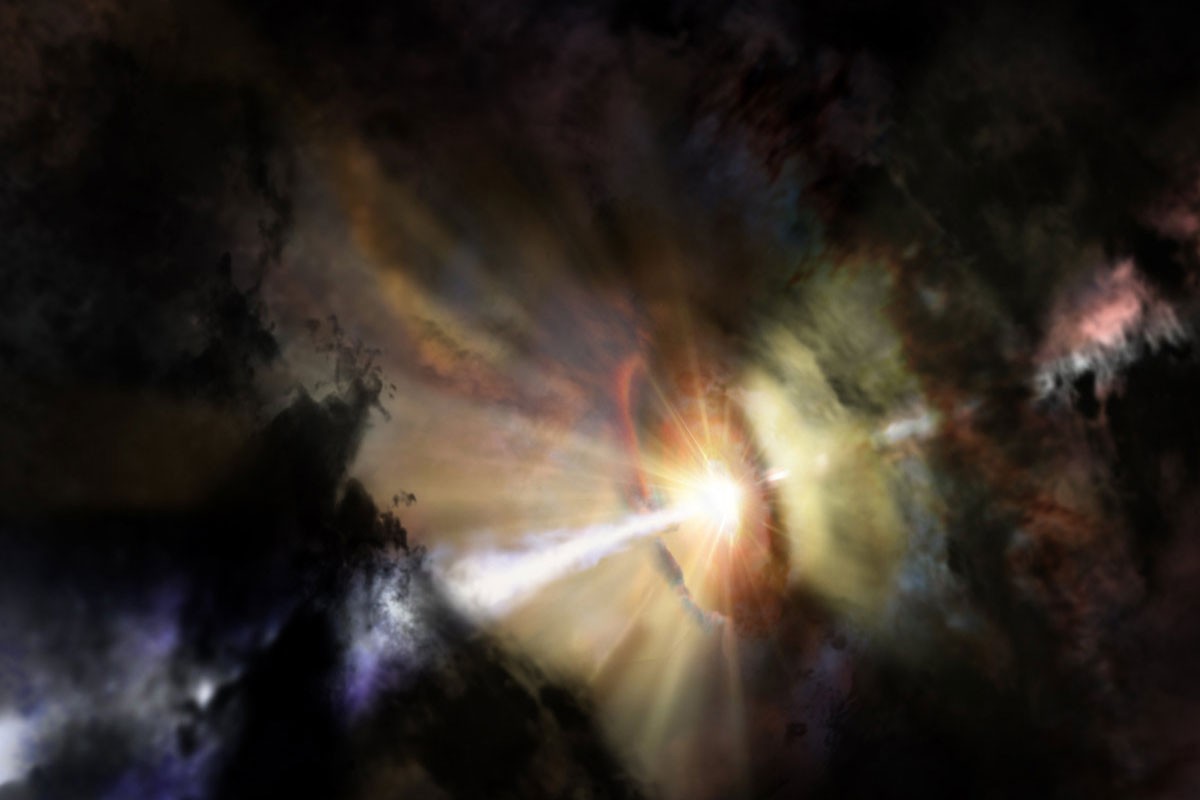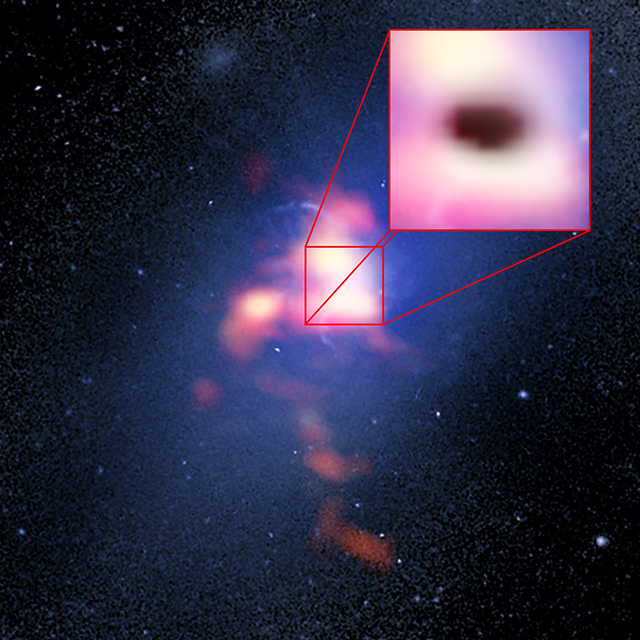
Deep in the heart of the Abell 2597 Brightest Cluster Galaxy, astronomers see a small cluster of giant gas clouds raining in on the central black hole. They were revealed by the billion light-year-long shadows they cast toward Earth. These ALMA data present the first observational evidence for predicted "chaotic, cold" accretion on a supermassive black hole. // Credit: NRAO/AUI/NSF; Dana Berry / SkyWorks; ALMA (ESO/NAOJ/NRAO)
Black hole weather report calls for clouds and cold intergalactic ‘rain’
An international team of astronomers has witnessed a never-before-seen cosmic weather event – a cluster of towering intergalactic gas clouds raining in on the supermassive black hole at the centre of a massive elliptical galaxy one billion light-years from Earth.
The clouds are traveling at speeds of up to 355 kilometres per second — that’s almost 800,000 miles per hour — and are almost certain to fall into the black hole, feeding its bottomless well. The observations, published in the journal Nature, represent the first direct evidence to support the theory that black holes feed on clouds of cold gas.
The new observation is the first direct evidence that dense clouds can coalesce out of hot, intergalactic gas and plunge into the heart of a galaxy to feed its central supermassive black hole. It also reshapes astronomers’ views on how supermassive black holes feed through a process known as accretion.
Astronomers Christopher O’Dea and Stefi A. Baum are part of an international team that made the observations and discovery. Baum is dean of the Faculty of Science at the University of Manitoba and O’Dea is a professor in the faculty’s department of physics and astronomy.

Composite image of Abell 2597 Brightest Cluster Galaxy. The background image (blue) is from the Hubble Space Telescope. The foreground (red) is ALMA data showing the distribution of carbon monoxide gas in and around the galaxy. The pull-out box is the ALMA data of the “shadow” (black) produced by absorption of the millimetre-wavelength light emitted by electrons whizzing around powerful magnetic fields generated by the galaxy’s black hole. Credit: B. Saxton (NRAO/AUI/NSF); G. Tremblay et al.; NASA/ESA Hubble; ALMA (ESO/NAOJ/NRAO)
O’Dea and Baum were key collaborators on the project which was carried out by their former PhD student, Grant Tremblay – now an Einstein Postdoctoral Fellow with Yale University in New Haven, Connecticut.
“This so-called cold, chaotic accretion has been a major theoretical prediction in recent years, but this is one of the first unambiguous pieces of observational evidence for a chaotic, cold ‘rain’ feeding a supermassive black hole,” said Tremblay, lead author on the paper appearing in the journal Nature.
The researchers made their detection using the Atacama Large Millimeter/submillimeter Array, or ALMA — one of the most powerful telescopes in the world, designed to see the oldest, most distant galaxies in the universe.
The team focused ALMA’s telescopes one billion light years away, on the central galaxy in the Abell 2597 Cluster, a galaxy which spans some tens of thousands of light years across. This particular galaxy is among the brightest in the universe, because of its special location at the center of a very massive cluster of galaxies.
Prior to the new discovery, astronomers believed that supermassive black holes in the universe’s largest galaxies fed on a slow and steady diet of very hot plasma surrounding those galaxies.
“Our first glimpse into the existence of in-falling cold gas in the galaxy came way back in 1994 when Stefi Baum, Jack Gallimore, and myself published Very Large Array observations which showed warm atomic hydrogen gas clouds in-falling towards the black hole,” O’Dea said.
“The new ALMA observations are telling us that the black holes can also be fed by massive clumps of very cold molecular gas.”
In much the same way that warm, humid air in Earth’s atmosphere can spawn rainclouds that precipitate, the hot atmosphere of gas in this cluster can cool and condense into in-falling clumps that rain into the central galaxy, fueling star formation.
When these massive clumps finally reach the black hole they will likely trigger a tremendous release of energy, which can drive away or destroy the massive clumps.
“Thus, the discovery of these massive clumps of cold molecular gas fueling the black hole activity updates our picture of the ‘feedback loop’ which maintains a balance between heat from the black hole and cooling of the ambient gas to form the cold clouds,” Baum said.
“This result is the first major result in a longer project to understand the dynamics of the cold gas and its relation to the energetic outflows created by the black hole,” she added.






